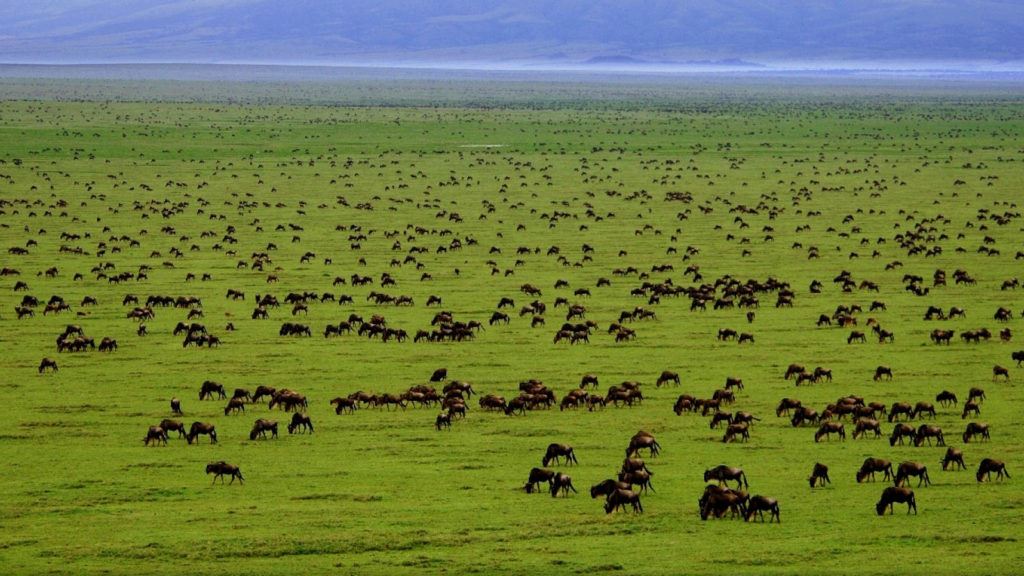Tour In 2024 2025 2026

In what is one of the world’s most essential wildlife experiences, the annual Great Migration in Africa is an event like no other. Millions of Wildebeest, hundreds of thousands of zebras and other antelope species make this incredible journey around 2,000 kilometers from the southern expanse of the Serengeti plains and Ngorongoro Crater over the borders of Kenya to Maasai Mara National Reserve and back down to the southern Serengeti again in search of food and water, facing Crocodile- infested waters and terrestrial predators (Lions, Leopards, etc) along the way. This is one of those world travel wish list items that we all dream of encountering during our lifetime. Here’s a brief guide on where, when, and why every nature lover should see it!
Serengeti is an essence of an African safari, boasting the largest diversity of wildlife than any game park in Africa. With vast grassland savannah as far as the eyes can see, you can easily spot impalas, African buffalos, Thomson’s gazelles, lions, elephants and other animals. The great Wildebeest Migration in Serengeti national park is something that needs to be seen to be believed. A movement of more than one million animals! This annual procession of wildebeest and zebras from the southern Serengeti into Kenya's Masai Mara draws tourist from all over the world. Whether you're in Tanzania to witness the calving season, the dramatic glimpse of river crossing, or the sheer size of the herd as it moves across the plains - Tanzania offers the absolute best opportunity to see this massive movement of animals.
It can well be argued that there is no real beginning or end to this migratory circuit – other than birth and death – but it seems reasonable to call the wildebeests’ calving season the start of the migration. Some 400,000 calves are born here within a period of two to three weeks - some 8,000 new calves every day. At this time of year the great herds of Wildebeest and Zebra are spread out across the southern Serengeti and Ngorongoro Conservation Area.
After bearing their young , around April the wildebeest herds commence their journey to north-west towards the fresher grass of the central Serengeti, going along with the with them thousands of zebra and smaller groups of antelope. By May, columns of wildebeest stretch for several kilometers as the animals start to congregate by the Moru Kopjes, close to Dunia Camp. Mating season begins towards the end of May and male wildebeest battle head-to-head. Throughout 'the rut', the journey continues at leisure, although this may not be a great time or place to witness the Great Migration, as heavy rains and flooded roads make reaching the herds very tough.
During June, the dry season begins; Wildebeest cross over the Grumeti River. Each migrating animal must face the challenge of crossing the crocodile-infested river - the first of many disconcerting and tense river encounters. As June moves into July, the hundreds of thousands of wildebeest and zebra continue to head north along the western edge of the park towards an even riskier barrier: the Mara River in the north of the Serengeti. These river crossings are arguably one of the most thrilling wildlife events on Earth.
Herds may still be scattered across the northern Serengeti, either about to cross into the Masai Mara or content to remain in Tanzania, grazing the rolling plains. The focus of the Migration, however, is firmly in Kenya where the wildebeest edge slowly eastwards through the Masai Mara. They’ll wander wherever there is fresh green grass, so you can also expect to encounter large herds in the conservancies surrounding the reserve. River crossings continue throughout the month, while abundant lion, cheetah and hyena are never short of prey.
Now the herds will begin to make their way south through Loliondo. They attempt to time their arrival on the southern Serengeti plains as the much-needed rains finally begin to fall. By now most, if not all, of the wildebeest and zebra will have left the Mara.
Herds may still be scattered across the northern Serengeti, either about to cross into the Masai Mara or content to remain in Tanzania, grazing the rolling plains. The focus of the Migration, however, is firmly in Kenya where the wildebeest edge slowly eastwards through the Masai Mara. They’ll wander wherever there is fresh green grass, so you can also expect to encounter large herds in the conservancies surrounding the reserve. River crossings continue throughout the month, while abundant lion, cheetah and hyena are never short of prey.
Serengeti National Park is a very safe place to visit as long as you follow the rules and guidelines set out by park staff and your guide. Incidents with wildlife are extremely rare on safaris, especially when everyone is there to respectfully view animals in their natural habitats. As malaria is present in the Serengeti, you should take measures to protect yourself. Apply DEET-based mosquito repellent (these formulations are the most effective) and take antimalarial medication. It's advisable that you cover up exposed skin in the evening too.